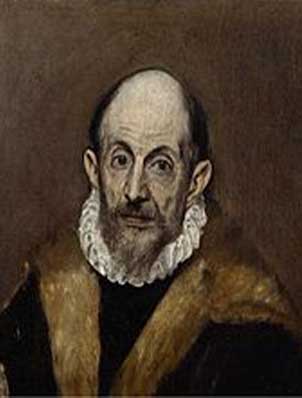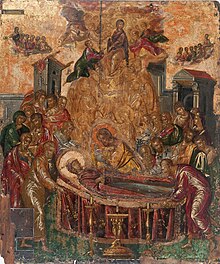Doménikos Theotokópoulos (Greek: Δομήνικος Θεοτοκόπουλος 1 October 1541 – 7 April 1614), most widely known as El Greco (“The Greek”), was a Greek painter, sculptor and architect of the Spanish Renaissance. “El Greco” was a nickname, and the artist normally signed his paintings with his full birth name in Greek letters, Δομήνικος Θεοτοκόπουλος (Doménikos Theotokópoulos), often adding the word Κρής (Krēs), which means Cretan.
El Greco was born in the Kingdom of Candia (modern Crete), which was at that time part of the Republic of Venice, Italy, and the center of Post-Byzantine art. He trained and became a master within that tradition before traveling at age 26 to Venice, as other Greek artists had done. In 1570, he moved to Rome, where he opened a workshop and executed a series of works. During his stay in Italy, El Greco enriched his style with elements of Mannerism and of the Venetian Renaissance taken from a number of great artists of the time, notably Tintoretto. In 1577, he moved to Toledo, Spain, where he lived and worked until his death. In Toledo, El Greco received several major commissions and produced his best-known paintings, such as View of Toledo and Opening of the Fifth Seal.
El Greco’s dramatic and expressionistic style was met with puzzlement by his contemporaries but found appreciation by the 20th century. El Greco is regarded as a precursor of both Expressionism and Cubism, while his personality and works were a source of inspiration for poets and writers such as Rainer Maria Rilke and Nikos Kazantzakis. El Greco has been characterized by modern scholars as an artist so individual that he belongs to no conventional school. He is best known for tortuously elongated figures and often fantastic or phantasmagorical pigmentation, marrying Byzantine traditions with those of Western painting.
Early years and family
The Dormition of the Virgin (before 1567, tempera and gold on panel, 61.4 × 45 cm, Holy Cathedral of the Dormition of the Virgin, Hermoupolis, Syros) was probably created near the end of the artist’s Cretan period. The painting combines post-Byzantine and Italian mannerist stylistic and iconographic elements.
Born in 1541, in either the village of Fodele or Candia (the Venetian name of Chandax, present day Heraklion) on Crete, El Greco was descended from a prosperous urban family, which had probably been driven out of Chania to Candia after an uprising against the Catholic Venetians between 1526 and 1528. El Greco’s father, Geórgios Theotokópoulos (d. 1556), was a merchant and tax collector. Nothing is known about his mother or his first wife, also Greek. El Greco’s older brother, Manoússos Theotokópoulos (1531–1604), was a wealthy merchant and spent the last years of his life (1603–1604) in El Greco’s Toledo home.
El Greco received his initial training as an icon painter of the Cretan school, a leading center of post-Byzantine art. In addition to painting, he probably studied the classics of ancient Greece, and perhaps the Latin classics also; he left a “working library” of 130 volumes at his death, including the Bible in Greek and an annotated Vasari book. Candia was a center for artistic activity where Eastern and Western cultures co-existed harmoniously, where around two hundred painters were active during the 16th century, and had organized a painters’ guild, based on the Italian model. In 1563, at the age of twenty-two, El Greco was described in a document as a “master” (“maestro Domenigo”), meaning he was already a master of the guild and presumably operating his own workshop. Three years later, in June 1566, as a witness to a contract, he signed his name in Greek as μαΐστρος Μένεγος Θεοτοκόπουλος σγουράφος (“Master Ménegos Theotokópoulos, painter”).
Most scholars believe that the Theotokópoulos “family was almost certainly Greek Orthodox”, although some Catholic sources still claim him from birth. Like many Orthodox emigrants to Catholic areas of Europe, some assert that he may have transferred to Catholicism after his arrival, and possibly practiced as a Catholic in Spain, where he described himself as a “devout Catholic” in his will. The extensive archival research conducted since the early 1960s by scholars, such as Nikolaos Panayotakis, Pandelis Prevelakis and Maria Constantoudaki, indicates strongly that El Greco’s family and ancestors were Greek Orthodox. One of his uncles was an Orthodox priest, and his name is not mentioned in the Catholic archival baptismal records on Crete. Prevelakis goes even further, expressing his doubt that El Greco was ever a practicing Roman Catholic.
Important for his early biography, El Greco, still in Crete, painted his Dormition of the Virgin near the end of his Cretan period, probably before 1567. Three other signed works of “Doménicos” are attributed to El Greco (Modena Triptych, St. Luke Painting the Virgin and Child, and The Adoration of the Magi).
Italy
It was natural for the young El Greco to pursue his career in Venice, Crete having been a possession of the Republic of Venice since 1211. Though the exact year is not clear, most scholars agree that El Greco went to Venice around 1567. Knowledge of El Greco’s years in Italy is limited. He lived in Venice until 1570 and, according to a letter written by his much older friend, the greatest miniaturist of the age, Giulio Clovio, was a “disciple” of Titian, who was by then in his eighties but still vigorous. This may mean he worked in Titian’s large studio, or not. Clovio characterized El Greco as “a rare talent in painting”.
In 1570, El Greco moved to Rome, where he executed a series of works strongly marked by his Venetian apprenticeship. It is unknown how long he remained in Rome, though he may have returned to Venice (c. 1575–76) before he left for Spain. In Rome, on the recommendation of Giulio Clovio, El Greco was received as a guest at the Palazzo Farnese, which Cardinal Alessandro Farnese had made a center of the artistic and intellectual life of the city. There he came into contact with the intellectual elite of the city, including the Roman scholar Fulvio Orsini, whose collection would later include seven paintings by the artist (View of Mt. Sinai and a portrait of Clovio are among them).
Unlike other Cretan artists who had moved to Venice, El Greco substantially altered his style and sought to distinguish himself by inventing new and unusual interpretations of traditional religious subject matter. His works painted in Italy were influenced by the Venetian Renaissance style of the period, with agile, elongated figures reminiscent of Tintoretto and a chromatic framework that connects him to Titian. The Venetian painters also taught him to organize his multi-figured compositions in landscapes vibrant with atmospheric light. Clovio reports visiting El Greco on a summer’s day while the artist was still in Rome. El Greco was sitting in a darkened room, because he found the darkness more conducive to thought than the light of the day, which disturbed his “inner light”. As a result of his stay in Rome, his works were enriched with elements such as violent perspective vanishing points or strange attitudes struck by the figures with their repeated twisting and turning and tempestuous gestures; all elements of Mannerism.
Portrait of Giorgio Giulio Clovio, the earliest surviving portrait from El Greco (c. 1570, oil on canvas, 58 × 86 cm, Museo di Capodimonte, Naples). In the portrait of Clovio, friend and supporter in Rome of the young Cretan artist, the first evidence of El Greco’s gifts as a portraitist are apparent.
By the time El Greco arrived in Rome, Michelangelo and Raphael were dead, but their example continued to be paramount, and somewhat overwhelming for young painters. El Greco was determined to make his own mark in Rome defending his personal artistic views, ideas and style. He singled out Correggio and Parmigianino for particular praise, but he did not hesitate to dismiss Michelangelo’s Last Judgment in the Sistine Chapel he extended an offer to Pope Pius V to paint over the whole work in accord with the new and stricter Catholic thinking. When he was later asked what he thought about Michelangelo, El Greco replied that “he was a good man, but he did not know how to paint”. And thus we are confronted by a paradox: El Greco is said to have reacted most strongly or even condemned Michelangelo, but found it impossible to withstand his influence. Michelangelo’s influence can be seen in later El Greco works such as the Allegory of the Holy League. By painting portraits of Michelangelo, Titian, Clovio and, presumably, Raphael in one of his works (The Purification of the Temple), El Greco not only expressed his gratitude but also advanced the claim to rival these masters. As his own commentaries indicate, El Greco viewed Titian, Michelangelo and Raphael as models to emulate. In his 17th century Chronicles, Giulio Mancini included El Greco among the painters who had initiated, in various ways, a re-evaluation of Michelangelo’s teachings.
Because of his unconventional artistic beliefs (such as his dismissal of Michelangelo’s technique) and personality, El Greco soon acquired enemies in Rome. Architect and writer Pirro Ligorio called him a “foolish foreigner”, and newly discovered archival material reveals a skirmish with Farnese, who obliged the young artist to leave his palace. On 6 July 1572, El Greco officially complained about this event. A few months later, on 18 September 1572, he paid his dues to the Guild of Saint Luke in Rome as a miniature painter. At the end of that year, El Greco opened his own workshop and hired as assistants the painters Lattanzio Bonastri de Lucignano and Francisco Preboste.
Read More : Wikipedia




